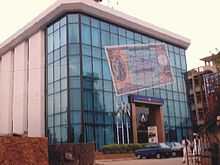Economy of Rawalpindi
The economy of Rawalpindi and the surrounding district has a diverse industrial base. With a population exceeding 3.2 million, Rawalpindi is the third largest city of the Punjab province of Pakistan, and the fourth largest city in the country. It is located in the northernmost part of Punjab, strategically connecting the region with Kashmir to the east and the province of Khyber Pakhtunkhwa to the north. It also borders Islamabad, the capital of Pakistan, of which it is considered a sister city of. It has historically been an important industrial and commercial center of the Punjab region.[1] Besides having an important railroad junction, the city has been one of the most important military cantonment areas in South Asia since the British Raj era.[1] The main industries of the city include oil refineries, gas processing, steel manufacturing, iron mills, railroad yards, a brewery, sawmills, tent factories, textiles, hosiery, pottery, leather goods production.,[1] transport and tourism.
Overview

After the decline of the Mughal Empire in the Indian subcontinent, Sikhs grabbed power in Punjab and settled in Rawalpindi in 1765, where they invited nearby traders to settle. This was regarded as a significant economic milestone in Rawalpindi's history, and the city gradually became a regional trade hub owing to its location between Punjab and Kashmir.[1]
During the British Raj, a military cantonment was established in the area. The army township aided in promoting commercial activity.[2]
References
| ||||||||||||||||||||||||||||||||||||||||||||||||||||||